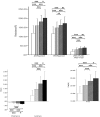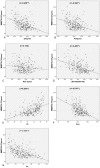Impulse oscillometry system as an alternative diagnostic method for chronic obstructive pulmonary disease
- PMID: 29145259
- PMCID: PMC5704804
- DOI: 10.1097/MD.0000000000008543
Impulse oscillometry system as an alternative diagnostic method for chronic obstructive pulmonary disease
Abstract
We aimed to compare impulse oscillation system (IOS) and traditional pulmonary function tests (PFTs) for the assessment of the severity of chronic obstructive pulmonary disease (COPD), and to assess the use of IOS parameters to identify patients who were forced expiratory volume in 1 second (FEV1)%pred < 50%.Patients with COPD (n = 215) were enrolled at the Ninth Hospital of Xi'an Affiliated Hospital of Xi'an Jiaotong University between October 2014 and September 2016. All patients were assessed by traditional PFT and IOS. Diagnostic performance of IOS parameters to determine indication for patients of FEV1%pred < 50% was assessed on receiver-operating characteristics (ROC) curve analysis.Out of 215 patients, 18, 83, 78, and 36 patients were classified as grade 1, 2, 3, and 4, respectively, according to the Global Initiative for Chronic Obstructive Lung Disease (GOLD) severity grading. On Spearman correlation analysis, FEV1%pred, MMEF 75%-25%, and residual volume/total lung capacity (RV/TLC) correlated with total respiratory impedance (Z5)%pred, resistance at 5 Hz (R5)-resistance at 20 Hz (R20), R5-R20% R5, R5, R5%pred, frequency response (Fres), reactance area (Ax), and reactance at 5 Hz (X5). On ROC curve analysis, the area under the curve (AUC) of X5 absolute value, Fres, Ax, Z5%pred, R5-R20, and R5-R20% R5 were 0.748, 0.755, 0.760, 0.705, 0.715, and 0.735, respectively, for COPD patients who required inhalational glucocorticoid therapy.IOS parameters showed a good correlation with traditional pulmonary function parameters; reactance parameters showed a stronger correlation than that of the resistance parameters. IOS can be used as an alternative method for pulmonary function assessment in patients with COPD with FEV1%pred < 50% who need inhalational glucocorticoid therapy.
Clinical trial registration number: ChiCTR-OCH-14004904.
Conflict of interest statement
The authors have no conflicts of interest to dosclose.
Figures







Similar articles
-
Application Value of Broadband 3-Dimensional Impulse Oscillometry in COPD.Int J Chron Obstruct Pulmon Dis. 2021 Feb 4;16:215-223. doi: 10.2147/COPD.S285927. eCollection 2021. Int J Chron Obstruct Pulmon Dis. 2021. PMID: 33574662 Free PMC article.
-
Clinical application value of impulse oscillometry in geriatric patients with COPD.Int J Chron Obstruct Pulmon Dis. 2017 Mar 15;12:897-905. doi: 10.2147/COPD.S129974. eCollection 2017. Int J Chron Obstruct Pulmon Dis. 2017. PMID: 28352170 Free PMC article.
-
Evaluation of respiratory impedance in patients with chronic obstructive pulmonary disease by an impulse oscillation system.Mol Med Rep. 2014 Nov;10(5):2694-700. doi: 10.3892/mmr.2014.2528. Epub 2014 Sep 2. Mol Med Rep. 2014. PMID: 25189185
-
Clinical Value of Impulse Oscillometry in Chronic Obstructive Pulmonary Disease: A Systematic Review and Meta-Analysis.Respiration. 2025;104(2):100-109. doi: 10.1159/000541633. Epub 2024 Oct 3. Respiration. 2025. PMID: 39362193
-
What can we learn about COPD from impulse oscillometry?Respir Med. 2018 Jun;139:106-109. doi: 10.1016/j.rmed.2018.05.004. Epub 2018 May 16. Respir Med. 2018. PMID: 29857993 Review.
Cited by
-
Small Airway Dysfunction in Chronic Bronchitis with Preserved Pulmonary Function.Can Respir J. 2022 Aug 24;2022:4201786. doi: 10.1155/2022/4201786. eCollection 2022. Can Respir J. 2022. PMID: 36060828 Free PMC article. Clinical Trial.
-
Peripheral airway function and disease burden in COPD.ERJ Open Res. 2025 Aug 4;11(4):01078-2024. doi: 10.1183/23120541.01078-2024. eCollection 2025 Jul. ERJ Open Res. 2025. PMID: 40761654 Free PMC article.
-
Short-term effect of particulate matter on lung function and impulse oscillometry system (IOS) parameters of chronic obstructive pulmonary disease (COPD) in Beijing, China.BMC Public Health. 2023 Jul 24;23(1):1417. doi: 10.1186/s12889-023-16308-0. BMC Public Health. 2023. PMID: 37488590 Free PMC article.
-
Long-term variability of impulse oscillometry and spirometry in stable COPD and asthma.Respir Res. 2022 Sep 21;23(1):262. doi: 10.1186/s12931-022-02185-5. Respir Res. 2022. PMID: 36131305 Free PMC article.
-
Different Smoking Statuses on Survival and Emphysema in Patients with Acute Exacerbation of Chronic Obstructive Pulmonary Disease.Int J Chron Obstruct Pulmon Dis. 2022 Mar 5;17:505-515. doi: 10.2147/COPD.S346456. eCollection 2022. Int J Chron Obstruct Pulmon Dis. 2022. PMID: 35281478 Free PMC article.
References
-
- Diaz-Guzman E, Mannino DM. Epidemiology and prevalence of chronic obstructive pulmonary disease. Clin Chest Med 2014;35:7–16. - PubMed
-
- Yin P, Wang H, Vos T, et al. A subnational analysis of mortality and prevalence of COPD in China from 1990 to 2013: findings from the global burden of disease study 2013. Chest 2016;150:1269–80. - PubMed
-
- Dettman SJ, Dowell RC, Choo D, et al. Long-term communication outcomes for children receiving cochlear implants younger than 12 months: a multicenter study. Otol Neurotol 2016;37:e82. - PubMed
Publication types
MeSH terms
LinkOut - more resources
Full Text Sources
Other Literature Sources
Medical

